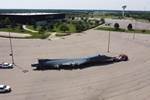NIAR AVET Lab at Wichita State University offers small unmanned aircraft testing
Small unmanned aircraft (sUA) certification capability complies with new FAA AC107-2A sUAS operations over people requirements.

sUA testing capabilities at NIAR AVET. Left depicts a launching device and anthropomorphic test dummy (ATD) setup. The right shows the university’s sUA Impact Launcher with Rigid Seat. Photo Credit: NIAR AVET
The (AVET) Lab at Wichita State University’s (NIAR, Kan., U.S.) is said to be well-known for its virtual engineering, numerical modeling methods and aircraft seat testing, but also boasts a small unmanned aircraft (sUA) certification capability. This development retains significance to the composites industry, per the extensive use of composites in unmanned aircraft.
AVET researchers, engineers and technicians are partially responsible for the research that led to new guidance for operating sUA over people in the National Airspace. Section 8.5.2 of FAA states applicants for Title 14 of the Code of Federal Regulations part 107 may use an FAA-accepted method of certification (MOC) developed by a voluntary consensus standards body or other entity, or an FAA-accepted MOC developed independent of the FAA.
Specifically, meets this requirement. This certification model was partially based on research conducted at NIAR AVET through the FAA’s . The test is conducted using a launching device and anthropomorphic test dummy (ATD) setup. NIAR AVET can conduct certification testing using ASTM F3389-20 sections 4.3 and 4.4 (methods B and C), and soon-to-be-approved Method D (section 4.5).
According to ASTM, method B uses an instrumented ATD head form and requires the applicant to conduct a series of impact tests using the sUA. Impacts are conducted at the most probable worst-case impact orientation, which is determined through a combination of engineering judgment and experiments. Method B is not appropriate for testing foam fixed-wing sUA due to the increased rigidity of the test setup.
Method C uses an instrumented ATD and requires impacts at multiple energies and three different impact angles. These test results can be compared to automotive injury risk metrics associated with 30% probability of an AIS 3 or greater injury or against defined injury metrics developed and used by the governing Civil Aviation Authority.
Method D uses an instrumented ATD head form and neck and requires the applicant to conduct a series of impact tests using the sUA and a rigid object. The test results of the sUA are compared with the results for rigid object at each orientation with the results of the head injury criterion (HIC15), Peak Acceleration, the Nij Neck Injury criterion and neck compression being the acceptance metrics. The weight limit for these Methods is eight lbf for sUA and up to 55 pound-force tested at parachute speeds for larger sUA.
An additional virtual method is also under review by ASTM. If approved, NIAR reports that it will be one of only a few places in the U.S. capable of conducing this certification test. Learn more about sUA testing available at NIAR AVET .
Related Content
-
The potential for thermoplastic composite nacelles
Collins Aerospace draws on global team, decades of experience to demonstrate large, curved AFP and welded structures for the next generation of aircraft.
-
Plant tour: Collins Aerospace, Riverside, Calif., U.S. and Almere, Netherlands
Composite Tier 1’s long history, acquisition of stamped parts pioneer Dutch Thermoplastic Components, advances roadmap for growth in thermoplastic composite parts.
-
Industrializing additive manufacturing in the defense/aerospace sector
GA-ASI demonstrates a path forward for the use of additive technologies for composite tooling, flight-qualified parts.






